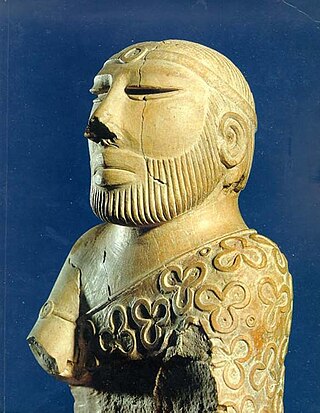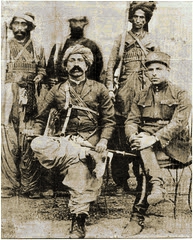
The Baloch or Baluch are a nomadic, pastoral, ethnic group which speaks the Western Iranic Baloch language and is native to the Balochistan region of South and Western Asia, encompassing the countries of Pakistan, Iran, and Afghanistan. There are also Baloch diaspora communities in neighbouring regions, including in Central Asia, and the Arabian Peninsula.

Reza Shah Pahlavi was an Iranian military officer and the founder of the Pahlavi dynasty. As a politician, he previously served as minister of war and prime minister of Qajar Iran and subsequently reigned as Shah of Pahlavi Iran from 1925 until he was forced to abdicate after the Anglo-Soviet invasion of Iran in 1941. He was succeeded by his eldest son, Mohammad Reza Shah. A modernizer, Reza Shah clashed with the Shia clergy, but also introduced many social, economic, and political reforms during his reign, ultimately laying the foundation of the modern Iranian State. Therefore, he is regarded by many as the founder of modern Iran.
Masjed Soleyman, also Romanized as Masjedsoleimān, Masjed-e Soleymān, Masjed Soleiman, and Masjid-i-Sulaiman, is a city in the Central District of Masjed Soleyman County, Khuzestan province, Iran, serving as capital of both the county and the district.

Sistan and Baluchestan province or Asli Baluchestan is the second largest province of the 31 provinces of Iran, after Kerman province, with an area of 180,726 km2. It is in the southeast of the country, bordering Afghanistan and Pakistan, and its capital is the city of Zahedan.
The Seistan Force, originally called East Persia Cordon, was a force of British Indian Army troops set up to prevent infiltration by German and Ottoman agents from Persia (Iran) into Afghanistan during World War I. The force was established to protect British interests in Persia from subversion by German agents, most notably Wilhelm Wassmuss. The force was also tasked to intercept and destroy the Turco-German expedition to Kabul that sought Afghan alliance in the Central war effort and Afghan assistance to wartime revolutionary conspiracies in British India.

The history of Balochistan refers to the history of the Balochistan region of Pakistan, Iran and Afghanistan. Vague allusions to the region were found in Greek historical records of around 650 BCE. Prehistoric Balochistan dates to the Paleolithic.

The Khanate of Kalat was a Brahui Khanate that originated in the modern-day Kalat region of Pakistan. Formed in 1666 due to the threat of Mughal expansion in the region, it controlled the wider Balochistan at its greatest extent in the mid-18th century, extending from Kerman in the west to Sindh in the east and from Helmand river in the north to the Arabian sea in the south. The Khanate of Kalat lost considerable area to Qajar Iran and the Emirate of Afghanistan in the early 19th century, and the city of Kalat was itself sacked by the British in 1839. Kalat became a self-governing state in a subsidiary alliance with British India after the signature of the Treaty of Kalat by the Khan of Kalat and the Baloch Sardars in 1875, and the supervision of Kalat became a task of the Baluchistan Agency. Kalat was briefly independent from 12 August 1947 until 27 March 1948, when its ruler Ahmad Yar Khan acceded to Pakistan, making it one of the Princely states of Pakistan.
Lehri tribe is a Baloch tribe in Balochistan, Pakistan. They are descended from the Rind Baloch and have emerged from the Domki tribe.

The Fourth Balochistan Conflict was a five-year military conflict in Balochistan, the largest province of Pakistan, between the Pakistan Army and Baloch separatists and tribesmen that lasted from 1973 to 1977.

Chakar Khan Rind (1468–1565) was a Baloch chieftain who founded the Second Baloch Confederacy (1487–1512). He also aided Mughal Emperor Humayun in his reconquest of the Subcontinent. He is considered a folk hero of the Baloch people and an important figure in the Baloch epic Hani and Sheh Mureed.

Balochistan is a historical region in Western and South Asia, located in the Iranian plateau's far southeast and bordering the Indian Plate and the Arabian Sea coastline. This arid region of desert and mountains is primarily populated by ethnic Baloch people.
Daadshah is a 1983 Iranian Persian-language film depicting the life and experiences of Baloch rebel Dad Shah in the Balochistan insurgency.

Khash is a city in the Central District of Khash County, Sistan and Baluchestan province, Iran, serving as capital of both the county and the district.
The Anglo-Marri Wars is the name given to three major military conflicts between the Marri Baloch tribesmen and the British Empire in the independent eastern Baloch tribal belt. The conflicts took place in the 19th and 20th centuries, specifically in 1840, 1880, and 1917.

Gul Khan Naseer also known as Malek o-Sho'arā Balochistan ; 14 May 1914 – 6 December 1983) was a Pakistani politician, poet, historian, and journalist from Balochistan. Most of his work is in Balochi language, but he also wrote in English, Urdu, Brahui and Persian.
1921 Persian coup d'état, known in Iran as 3 Esfand 1299 coup d'état, refers to several major events in Qajar Persia in 1921, which eventually led to the deposition of the Qajar dynasty and the establishment of the Pahlavi Empire as the ruling house of the country in 1925.

Dost Mohammad Khan Baloch, also known as Mir Dost Muhammad Khan Baluch, was a ruler in Iranian (Western) Baluchistan from 1921 till 1928.

The Simko Shikak revolt refers to an armed Ottoman-backed tribal Kurdish uprising against the Qajar dynasty of Iran from 1918 to 1922, led by Kurdish chieftain Simko Shikak from the Shekak tribe.

During the mid-eighteenth century the Afsharid empire of Nader Shah embarked upon the conquest and annexation of the Khanates of Bukhara and Khiva. The initial engagements were fought in the late 1730s by Nader Shah's son and viceroy Reza Qoli Mirza who gained a few notable victories in this theatre while Nader was still invading India to the south. Reza Qoli's invasions of Khiva angered Ilbars Khan, the leader of Khiva. When Ilbars threatened to make a counter-attack Nader ordered hostilities to cease despite his son's successes and later returned victoriously from Delhi to embark on a decisive campaign himself.

Nader's Dagestan campaign, were the campaigns conducted by the Persian Empire under its Afsharid ruler Nader Shah between the years 1741 and 1743 in order to fully subjugate the Dagestan region in the North Caucasus Area. The conflict between the Persian Empire & the Lezgins and a myriad of other Caucasian tribes in the north was intermittently fought through the mid-1730s during Nader's first short expedition in the Caucasus until the last years of his reign and assassination in 1747 with minor skirmishes and raids. The incredibly difficult terrain of the northern Caucasus region made the task of subduing the Lezgins an extremely challenging one. Despite this Nader Shah gained numerous strongholds and fortresses from the Dagestanis and pushed them to the very verge of defeat. The Lezgins however held on in the northernmost reaches of Dagestan and continued to defy Persian domination.














